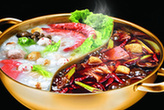A technique appearing in the Ming Dynasty (1368-1644), hundred-treasure inlays introduced a new lacquer species with distinctive characteristics of that time.
Hundred-treasure inlays originated from the traditional technique of mother-of-pearl inlays, in which process people make the thin grinded lustrous slices of mussel conchs into patterns of human figures, flowers, grasses, birds and animals, embed the patterns into the concave patterns carved in advance, apply a layer of varnish lacquer on the embedded patterns, and finally, after the lacquer dries up, polish the lacquer until the decorative inlays are revealed. On the basis of mother-of-pearl inlay, precious materials like ivory, corals, emeralds and jades are included for hundred-treasure inlays. On the surface of a lacquerwork are embedded various relief patterns.
Lacquer ware of hundred-treasure inlays includes folding screen, table plaque, hanging screen, tables, cabinets, boxes, benches, stands, trays and the like. The changes of the angles of the shining light will cast various shades of luster on the patterns of hundred-treasure inlays, conjuring up a rainbow of colors and displaying an air of nobility and magnificence. Hence the hundred-treasure inlay distinguishes itself as a peculiar species of lacquerwork.
Editor: Liu Xiongfei





Why not rent a boyfriend, or girlfriend to please parents during the Spring Festival?